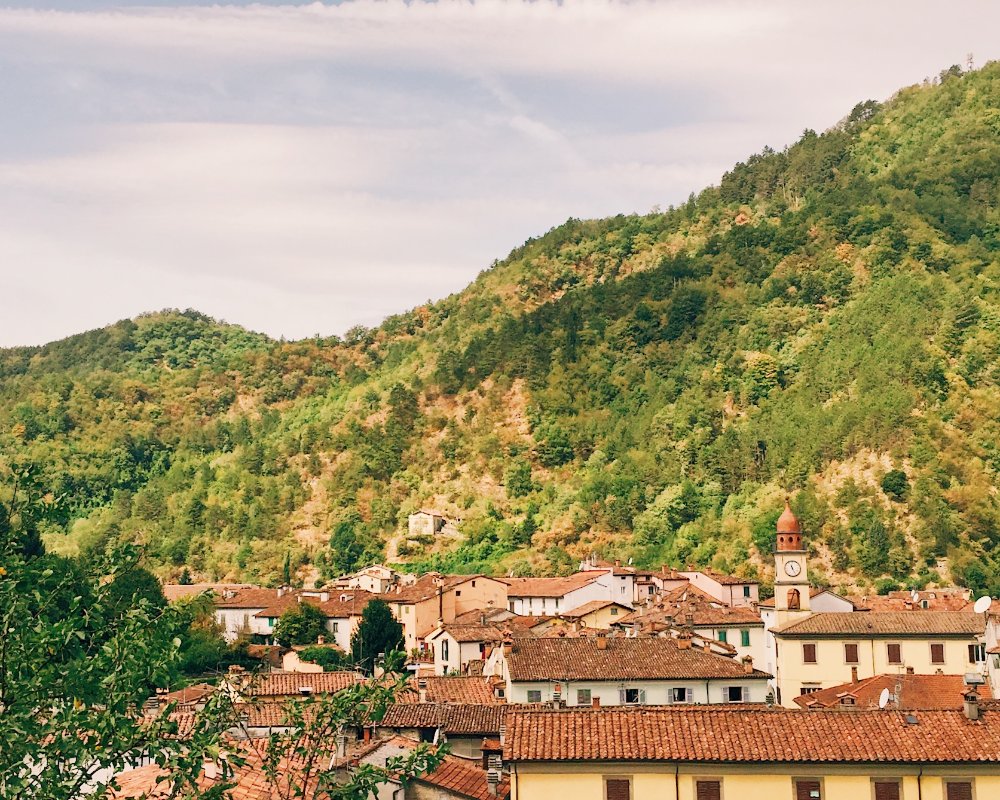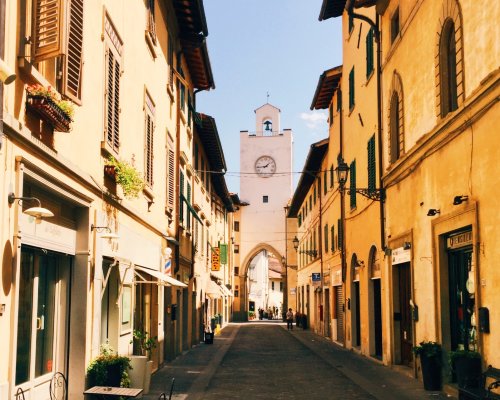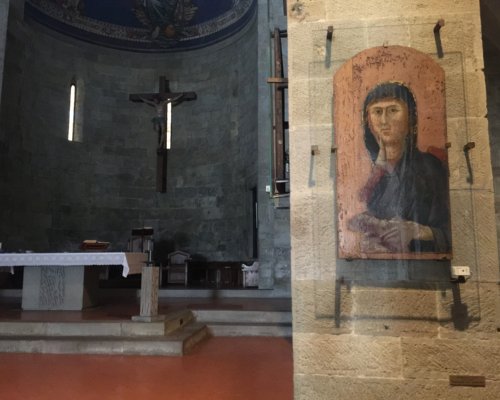3-day itinerary on board the first Trans-Apennines train of Italy
The Mugello area can be reached by train thanks to the first Italian trans-Apennines railway: the Faentina railway. The railway line connects Florence to Faenza (and then Ravenna) and passes through the Apennines mountains between Tuscany and Emilia-Romagna, stopping by some beautiful towns in this area located at north-east of Florence. It is also called Dante’s train because it connects Florence, the birthplace of Dante, to Ravenna, his burial place.
It was inaugurated on April 23rd 1893: the new railway line was 101 km long and counted 30 galleries, 55 bridges and viaducts, 18 overpasses and 15 rail stations in between. The Faentina railway rises till 578 meters above the sea level and offers breathtaking views along the way.
The regional trains to Borgo San Lorenzo depart generally from platform 17, at the very end of Santa Maria Novella train station. Pay attention to take the train to Faenza and not the train passing by Pontassieve, because the trip is longer.
Right after leaving the train station let's look out to spot the Brunelleschi’s Cupola out of the window, and then relax for the rest of the trip — about 40 minutes to reach Borgo San Lorenzo. When in Borgo San Lorenzo let's walk to Piazza Garibaldi, a good starting point to explore the town of the Mugello that has been recently entitled “city of ceramics”.
We enter the Romanesque Church of San Lorenzo, founded in 941: inside we admire a beautiful Madonna with child, attributed to Giotto and the frescoes by Galileo Chini in the apse. By Dino Chini, another artistic member of the famous Chini family that kind of invented the Italian Liberty style, are the decorations inside the Palazzo del Podestà; this palazzo was built in the Middle Ages and was the siege of local government, as testified by the many and different coat of arms on its facade.
Dino Chini restored also the Clock Tower, the landmark of Borgo San Lorenzo, that was originally built in 1351. We’re now in Corso Matteotti, the main street of the city where you find shops and cafèterias. At the corner of the Clock tower we take Via San Martino to see part of the original medieval walls of the city. At the end of the street, we reach the 14th century Porta Fiorentina, that was the main gate to the city from and to Florence.
After we’ve visited the city center we walk to Villa Pecori Giraldi, that hosts the Chini Manufacture Museum; the museum recounts the history of the Chini family and its manufacture of ceramics, stoneware and glasware. The most important figure was Galileo Chini (1873-1956), relevant artist of the Italian Art Nouveau style, who worked not just in Florence and surroundings, but was called by the king of Siam to paint the throne hall of the Royal Palace.
Not to be missed is the statue of Fido in Piazza Dante next to the Town Hall, also known as the Italian Hachiko and celebrating a story of loyalty and love between Fido the dog and his owner, dead in a bomb attack in WWII.
The regional trains to Borgo San Lorenzo depart generally from platform 17, at the very end of Santa Maria Novella train station. Pay attention to take the train to Faenza and not the train passing by Pontassieve, because the trip is longer.
Right after leaving the train station let's look out to spot the Brunelleschi’s Cupola out of the window, and then relax for the rest of the trip — about 40 minutes to reach Borgo San Lorenzo. When in Borgo San Lorenzo let's walk to Piazza Garibaldi, a good starting point to explore the town of the Mugello that has been recently entitled “city of ceramics”.
We enter the Romanesque Church of San Lorenzo, founded in 941: inside we admire a beautiful Madonna with child, attributed to Giotto and the frescoes by Galileo Chini in the apse. By Dino Chini, another artistic member of the famous Chini family that kind of invented the Italian Liberty style, are the decorations inside the Palazzo del Podestà; this palazzo was built in the Middle Ages and was the siege of local government, as testified by the many and different coat of arms on its facade.
Dino Chini restored also the Clock Tower, the landmark of Borgo San Lorenzo, that was originally built in 1351. We’re now in Corso Matteotti, the main street of the city where you find shops and cafèterias. At the corner of the Clock tower we take Via San Martino to see part of the original medieval walls of the city. At the end of the street, we reach the 14th century Porta Fiorentina, that was the main gate to the city from and to Florence.
After we’ve visited the city center we walk to Villa Pecori Giraldi, that hosts the Chini Manufacture Museum; the museum recounts the history of the Chini family and its manufacture of ceramics, stoneware and glasware. The most important figure was Galileo Chini (1873-1956), relevant artist of the Italian Art Nouveau style, who worked not just in Florence and surroundings, but was called by the king of Siam to paint the throne hall of the Royal Palace.
Not to be missed is the statue of Fido in Piazza Dante next to the Town Hall, also known as the Italian Hachiko and celebrating a story of loyalty and love between Fido the dog and his owner, dead in a bomb attack in WWII.
In about 30 minutes we’re in Marradi, hidden gem of the Romagna Toscana, that area in between Tuscany and Emilia Romagna where people are Tuscans but use the typical Romagna dialect and food is a good mixture of both traditions. It’s different from all the other towns in the Apennines because it was the refuge of many noble families exiled from Milan, Florence, and other important cities of North Italy in the 16th century, that built here their elegant palaces.
While we walk from the train station to the city center, let's stop for a moment in front of the house where the Italian poet Dino Campana was born - there are two large plaques, you recognize it. He is also known as the “Italian Rimbaud” and had an intense and troubled love-affair with the Florentine poetess Sibilla Aleramo at the beginning of the 20th century. Dino Campana had a strong relationship with Marradi: thanks to the money of 44 citizens of Marradi he printed his first (and only) work The Orphic Songs. We recommend to visit the Centro Studi Campaniani that hosts a little museum recounting the work and troubled life of this visionary poet.
Then we visit the Church of San Lorenzo that hosts the Renaissance masterpieces by the Master of Marradi, student of Domenico Ghirlandaio whose other artworks are on display at the National Gallery, London. Not to be missed Palazzo Torriani: this noble building has been property of the Torriani family since the 16th century and preserves a beautiful collection of clocks and original furniture, as well as unique artworks in Liberty Style by Galileo Chini - guided tours should be booked in advance.
Last but not least there is the Marron Buono di Marradi: it’s a very fine chestnut cultivated in the municipality of Marradi; every Sunday in October there is a special festival to celebrate, Sagra delle Castagne di Marradi, this delicious fruit that is used to prepare cakes, sweets but also pasta.
In about 30 minutes we’re in Marradi, hidden gem of the Romagna Toscana, that area in between Tuscany and Emilia Romagna where people are Tuscans but use the typical Romagna dialect and food is a good mixture of both traditions. It’s different from all the other towns in the Apennines because it was the refuge of many noble families exiled from Milan, Florence, and other important cities of North Italy in the 16th century, that built here their elegant palaces.
While we walk from the train station to the city center, let's stop for a moment in front of the house where the Italian poet Dino Campana was born - there are two large plaques, you recognize it. He is also known as the “Italian Rimbaud” and had an intense and troubled love-affair with the Florentine poetess Sibilla Aleramo at the beginning of the 20th century. Dino Campana had a strong relationship with Marradi: thanks to the money of 44 citizens of Marradi he printed his first (and only) work The Orphic Songs. We recommend to visit the Centro Studi Campaniani that hosts a little museum recounting the work and troubled life of this visionary poet.
Then we visit the Church of San Lorenzo that hosts the Renaissance masterpieces by the Master of Marradi, student of Domenico Ghirlandaio whose other artworks are on display at the National Gallery, London. Not to be missed Palazzo Torriani: this noble building has been property of the Torriani family since the 16th century and preserves a beautiful collection of clocks and original furniture, as well as unique artworks in Liberty Style by Galileo Chini - guided tours should be booked in advance.
Last but not least there is the Marron Buono di Marradi: it’s a very fine chestnut cultivated in the municipality of Marradi; every Sunday in October there is a special festival to celebrate, Sagra delle Castagne di Marradi, this delicious fruit that is used to prepare cakes, sweets but also pasta.
On our way back to Florence let's stop in Crespino del Lamone. This tiny village on the river Lamone is renowned as the village of good water and many fountains. There are many trails for hiking and biking and in Summer you can take a bath in one of the may natural pools of Mugello.
A good hike is from Marradi to Crespino (about 4 hours) that could be a good alternative to the train. Not to be missed is the monument commemorating the WWII massacre by the Nazis happened on July 17th in 1944. Also the Church of Santa Maria Nascente is a must-see: inside this centuries-old church is preserved a large fragment of 14th century altarpiece by Jacopo del Casentino, depicting The Enthroned Madonna with child and angels.
This railway trip is recommended any time of the year: the beautiful landscape outside of the windows will change accordingly, turning from intense green of Spring and Summer to orange of Autumn. Spring is good for hiking, Summer is good for the cold breeze, Autumn is good for chestnuts and Winter is good for the snowy landscapes.
You may download a free guidebook at mugellotoscana.it
On our way back to Florence let's stop in Crespino del Lamone. This tiny village on the river Lamone is renowned as the village of good water and many fountains. There are many trails for hiking and biking and in Summer you can take a bath in one of the may natural pools of Mugello.
A good hike is from Marradi to Crespino (about 4 hours) that could be a good alternative to the train. Not to be missed is the monument commemorating the WWII massacre by the Nazis happened on July 17th in 1944. Also the Church of Santa Maria Nascente is a must-see: inside this centuries-old church is preserved a large fragment of 14th century altarpiece by Jacopo del Casentino, depicting The Enthroned Madonna with child and angels.
This railway trip is recommended any time of the year: the beautiful landscape outside of the windows will change accordingly, turning from intense green of Spring and Summer to orange of Autumn. Spring is good for hiking, Summer is good for the cold breeze, Autumn is good for chestnuts and Winter is good for the snowy landscapes.
You may download a free guidebook at mugellotoscana.it


